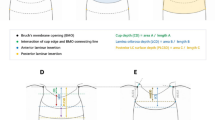Abstract
Purpose
To investigate if a new ultrasound biomicroscopy (UBM) parameter, iris lens distance (ILD), and its model could predict clinically significant intraocular pressure (IOP) elevation after darkroom provocative test (DRPT).
Methods
Cases with a peripheral anterior chamber depth less than one-fourth corneal thickness were enrolled. All subjects underwent UBM examination and DRPT if possible. Anterior chamber depth (ACD) and ILD were measured in the central axis at different positions in dark (ACDD, ILDD) and bright (ACDB, ILDB). An IOP elevation over 5 mmHg and 8 mmHg was set as cutoffs for a positive DRPT result (positive-5 and positive-8). SAS 9.3 statistical software was used to manage and analyze data and calculate the linear probability model (LPM). Another 17 patients (34 eyes) were included to validate the model.
Results
Two hundred and ten (210) UBM images qualified for analysis. ILD was significantly less in the dark than in the bright and in patients with a positive DRPT result (p < 0.001). The LPM for positive-5 and positive-8 were P = 1.14 + (− 0.49*ILDD) + (− 0.41*ACDD) (n = 210, R2 = 0.1079, AUC = 0.715), and P = 0.87 + (− 0.44*ILDD) + (− 0.35*ACDD) (n = 210, R2 = 0.1358, AUC = 0.807), respectively.
Conclusions
LPMs based on ILD could predict the risk of an IOP elevation over 5 mmHg or 8 mmHg. The LPM for positive-8 reached a good level of diagnostic accuracy.



Similar content being viewed by others
References
Foster PJ, Baasanhu J, Alsbirk PH et al (1996) Glaucoma in Mongolia. A population-based survey in Hovsgol province, northern Mongolia. Arch Ophthalmol 114(10):1235–1241
Foster PJ, Oen FT, Machin D et al (2000) The prevalence of glaucoma in Chinese residents of Singapore: a cross-sectional population survey of the Tanjong Pagar district. Arch Ophthalmol 118(8):1105–1111
Dandona L, Dandona R, Mandal P et al (2000) Angle-closure glaucoma in an urban population in southern India. The Andhra Pradesh eye disease study. Ophthalmology 107(9):1710–1716
He M, Foster PJ, Ge J et al (2006) Prevalence and clinical characteristics of glaucoma in adult Chinese: a population-based study in Liwan District, Guangzhou. Invest Ophthalmol Vis Sci 47(7):2782–2788
Foster PJ, Johnson GJ (2001) Glaucoma in China: how big is the problem? Br J Ophthalmol 85(11):1277–1282
Quigley HA, Broman AT (2006) The number of people with glaucoma worldwide in 2010 and 2020. Br J Ophthalmol 90(3):262–267
Jiang Y, He M, Huang W et al (2010) Qualitative assessment of ultrasound biomicroscopic images using standard photographs: the liwan eye study. Invest Ophthalmol Vis Sci 51(4):2035–2042
Narayanaswamy A, Vijaya L, Shantha B et al (2004) Anterior chamber angle assessment using gonioscopy and ultrasound biomicroscopy. Jpn J Ophthalmol 48(1):44–49
Ishikawa H, Liebmann JM, Ritch R (2000) Quantitative assessment of the anterior segment using ultrasound biomicroscopy. Curr Opin Ophthalmol 11(2):133–139
Wang B, Congdon NG, Wang N et al (2010) Dark room provocative test and extent of angle closure: an anterior segment OCT study. J Glaucoma 19(3):183–187
Ku JY, Nongpiur ME, Park J et al (2014) Qualitative evaluation of the iris and ciliary body by ultrasound biomicroscopy in subjects with angle closure. J Glaucoma 23(9):583–588
Sihota R, Dada T, Gupta R et al (2005) Ultrasound biomicroscopy in the subtypes of primary angle closure glaucoma. J Glaucoma 14(5):387–391
GORIN G (1965) Provocative tests in angle-closure Glaucoma; Importance of Gonioscopic Control. Am J Ophthalmol 60:235–241
Harris LS, Galin MA (1972) Prone provocative testing for narrow angle glaucoma. Arch Ophthalmol 87(5):493–496
Wilensky JT, Kaufman PL, Frohlichstein D et al (1993) Follow-up of angle-closure glaucoma suspects. Am J Ophthalmol 115(3):338–346
Desgroseilliers A, Harasymowycz PJ, Kamdeu-Fansi A et al (2014) Gonioscopic Findings Associated With a Positive Dark-room Provocative Test in Narrow Angles After Laser Iridotomy. J Glaucoma 23:337–340
Acknowledgements
We would like to thank the patients for taking part in this research.
Author information
Authors and Affiliations
Corresponding author
Ethics declarations
Conflict of interest
The authors declare that they have no conflict of interest.
Ethical approval
All procedures performed in studies involving human participants were in accordance with the ethical standards of the (Institutional Review Board of Peking Union Medical College Hospital) and with the 1964 Helsinki declaration and its later amendments or comparable ethical standards.
Informed consent
Informed consent was obtained from all individual participants included in the study.
Additional information
Publisher’s note
Springer Nature remains neutral with regard to jurisdictional claims in published maps and institutional affiliations.
Rights and permissions
About this article
Cite this article
Liu, X., Zhang, Y., Li, L. et al. Iris lens distance to predict the risk of intraocular pressure elevation after dark room provocative test. Graefes Arch Clin Exp Ophthalmol 257, 2723–2728 (2019). https://doi.org/10.1007/s00417-019-04459-z
Received:
Revised:
Accepted:
Published:
Issue Date:
DOI: https://doi.org/10.1007/s00417-019-04459-z




